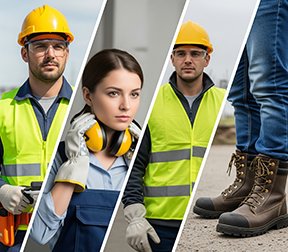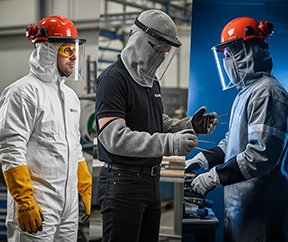Published: August 07, 2025 | Updated: October 23, 2025
Published: August 07, 2025 | Updated: October 23, 2025
Essential Guide to Personal Protective Equipment (PPE) for Industrial Safety
 In many industries, maintenance personnel adhere to specific regulations and policies before, during, and after completing tasks. This often involves employing specialized tools and wearing protective clothing. This article delves into the concept of Personal Protection Equipment, examining its advantages, showcasing various examples, and illustrating how a computerized maintenance management system (CMMS) assists technicians in upholding safety standards.
In many industries, maintenance personnel adhere to specific regulations and policies before, during, and after completing tasks. This often involves employing specialized tools and wearing protective clothing. This article delves into the concept of Personal Protection Equipment, examining its advantages, showcasing various examples, and illustrating how a computerized maintenance management system (CMMS) assists technicians in upholding safety standards.
Defining Personal Protective Equipment (PPE)
Personal Protective Equipment, or PPE, encompasses any item safeguarding an individual from exposure to potentially harmful substances or conditions. For maintenance professionals, PPE ranges from safety glasses to full-body suits, providing a crucial barrier against workplace hazards.
Why PPE Matters in Industrial Maintenance
While the advantages of PPE might appear self-evident, consistent reinforcement of its importance fosters a safety-conscious mindset among personnel. Deploying PPE delivers several critical benefits.
Injury Prevention
Technicians frequently operate in hazardous environments. Protecting their well-being remains paramount. Employing PPE helps avoid injuries, ranging from minor abrasions to severe incidents, safeguarding personnel from immediate harm.
Illness Prevention
Personal protection also contributes to preventing work-related illnesses. PPE shields workers from exposure to harmful chemicals, biological agents, and airborne contaminants, minimizing the risk of developing short-term or chronic health conditions.
Regulatory Compliance
Numerous industries enforce strict regulations concerning PPE use. Disregarding these mandates leads to substantial fines and legal repercussions. Adhering to PPE guidelines ensures a compliant and legally sound operational environment.
Elevated Productivity
By preventing injuries and illnesses, PPE contributes to improved employee morale and a reduction in operational downtime. A healthier, safer workforce maintains higher levels of efficiency and output.
Types of PPE for Maintenance and Industrial Safety
Different industries and tasks require specific types of protective equipment. However, certain PPE items consistently appear across various maintenance fields. Understanding the characteristics of each category helps in making informed selections for optimal protection.
Eye Protection: Glasses and Goggles
Safety glasses shield eyes from flying debris, chemical splashes, and other hazards. When selecting safety glasses, consider lens material that offers clarity, scratch resistance, and impact protection. A comfortable and secure fit, with adjustable nose pads and temple length, ensures extended wear without discomfort. Look for models offering side shields, UV protection, and chemical resistance. Always verify compliance with the American National Standards Institute standards.
Safety goggles provide more comprehensive eye protection than safety glasses, particularly when personnel handle hazardous chemicals or liquids. The same quality aspects apply to goggles, with an added emphasis on ventilation features to prevent fogging and maintain comfort during use.
Hearing Protection: Earplugs and Earmuffs
Earplugs or earmuffs protect ears from excessive noise exposure, a common cause of hearing loss in industrial settings. When choosing hearing protection, prioritize a proper noise reduction rating (NRR). Comfortable fit remains crucial for consistent use. Ensure compatibility with other PPE items worn simultaneously.
Respiratory Protection
Respirators protect lungs from airborne contaminants such as dust, fumes, and gases. The specific hazard dictates the type of respirator required. Key considerations include filter efficiency, proper fit and comfort, ease of donning and doffing, clear usage instructions, compatibility with other PPE, ease of cleaning, and the availability of replacement parts. Look for approval from the National Institute for Occupational Safety and Health (NIOSH).
Hand Protection: Gloves
Gloves protect hands from cuts, burns, chemical exposure, and other hazards. The type of glove depends on the task and materials handled. Seek gloves made from appropriate materials offering resistance to cuts, chemicals, abrasions, extreme temperatures, and slips. Proper fit, dexterity, and adequate length ensure effective protection and functionality. Reinforced palms and fingers add durability and protection. Check for American Society for Testing and Materials (ASTM) standards compliance.
Head Protection: Hard Hats
Hard hats protect the head from falling objects and other impact hazards. They require high impact resistance. Select a class rating of "G" for general impact protection or "E" for electrical protection. Durability, comfort, and a secure suspension system are important. Consider models with ventilation and high visibility features.
Foot Protection: Safety Shoes
Safety shoes protect feet from punctures, crush injuries, and electrical hazards. When choosing safety footwear, prioritize high impact, compression, puncture, and slip resistance. An electrical hazard rating offers additional safety. Steel or composite toes provide substantial protection. Comfort, proper fit, and durability ensure long-term wearability.
Body Protection: Specialized Suits and Clothing
 In certain situations, maintenance technicians require body armor to protect against physical harm. Options include soft armor with ballistic (Kevlar or aramid fiber) and stab-resistant panels, hard armor with ceramic or metallic plates, and hybrid designs combining soft and hard elements. Specialized armor such as riot gear and explosive ordnance disposal suits addresses unique threats.
In certain situations, maintenance technicians require body armor to protect against physical harm. Options include soft armor with ballistic (Kevlar or aramid fiber) and stab-resistant panels, hard armor with ceramic or metallic plates, and hybrid designs combining soft and hard elements. Specialized armor such as riot gear and explosive ordnance disposal suits addresses unique threats.
Full-body suits deliver protection from hazardous chemicals, biological agents, and other contaminants. Examples include chemical suits, with various types designed for specific chemical threats; biological suits, categorized into four protection levels; fire-resistant suits; radiation suits; and anti-static suits.
Fire-resistant clothing protects workers exposed to fire or high temperatures. These garments feature high flame resistance and receive flame-retardant treatments. Heat resistance, durability, comfort, and high visibility are important attributes.
Cut-resistant clothing shields the body from sharp objects. Materials such as Kevlar, Spectra, Dyneema, and metal mesh provide varying degrees of cut protection. Hybrid clothing combines different materials for enhanced safety.
Chemical-resistant clothing demands quality material, penetration resistance, proper fit and ventilation, and durability to provide effective protection against hazardous substances.
Thermal protection safeguards workers exposed to extreme temperatures. Materials like Nomex offer flame resistance, while aluminized fabrics, polar fleece, and waterproof fabrics provide insulation and protection against cold or wet conditions.
Fall Protection
Harnesses and lifelines constitute essential equipment for workers performing tasks at heights, preventing falls and mitigating injury should a fall occur.
Emergency Response Equipment
In the event of an incident, preparedness remains vital. Maintenance technicians should readily access first aid kits, eyewash stations, and material safety data sheets (MSDS). Departments must establish and regularly review a comprehensive emergency response plan.
Complementary Safety Tools and Protective Accessories
Beyond personal wearables, other protective measures enhance worker and equipment safety during daily activities. These tools and accessories contribute significantly to a secure work environment.
- Covers: Prevent tools from damage, scratches, or contamination during storage or transportation.
- Cases: Furnish organized storage and protection for tools, particularly when working in the field.
- Belts: Keep tools accessible and secure while working, reducing the likelihood of drops or misplacement.
- Pouches: Offer additional storage for smaller tools or accessories, maintaining order and accessibility.
- Storage Cabinets: Provide secure, organized storage for tools and equipment, preventing theft and damage.
- Lockboxes: Prevent unauthorized access to tools and equipment, ensuring their security and controlled use.
- Sharpeners: Maintain the sharpness and efficiency of cutting tools, improving performance and safety.
- Lubricants: Reduce friction and wear on moving parts of tools and equipment, extending their lifespan.
- Cleaning Supplies: Keep tools and equipment clean and free of contaminants, preventing cross-contamination and prolonging usability.
- Protective Coatings: Apply coatings to tools and equipment to shield them from corrosion, rust, and other forms of damage.
Discover how streamlined maintenance processes can elevate production. Learn more.
How CMMS Software Enhances PPE Compliance and Safety
Computerized Maintenance Management System (CMMS) software significantly assists in protecting technicians through several key functionalities.
Checklists for Guided Procedures
Certain assets demand a specific order for repairs or preventive maintenance, including inspections and lubrication. A CMMS allows the creation of detailed checklists that attach to work orders. These checklists provide technicians with clear, step-by-step instructions for completing each job, ensuring all safety protocols and equipment requirements receive attention. Simple checklists offer basic completion boxes, while advanced checklists include data fields for recording information, such as yes/no answers, temperature readings, pressure levels, and percentages.
Attachments for Comprehensive Guidance
Images, URLs for video instructions, and comprehensive documentation accompany work orders within a CMMS. This documentation includes policies for PPE usage, ensuring technicians have access to all necessary information to perform tasks safely and correctly. Visual aids and detailed procedures reduce ambiguity and enhance adherence to safety standards.
Kitted Parts for Preparedness
Instead of technicians searching for individual parts for a job, a CMMS supports the assembly of pre-kitted packages. These kits, often in pouches or bags, contain all required parts and the necessary PPE for a specific task. This method saves time and ensures technicians have immediate access to all safety gear before beginning work, significantly improving preparedness and safety compliance.
Vendor Purchasing History
Technicians will know who to contact to buy more protective gear, keeping track of its unit price and any available discounts for bulk orders. Perhaps there is more than one choice, and if one vendor is out or has a long delivery date, they will know where else to go based upon historical data, kept handily in one place with all the other supporting documentation: within the CMMS.
Prioritizing PPE for a Safer Industrial Workplace
Gaining an understanding of personal protection equips individuals with the knowledge and the safety equipment necessary to perform their duties securely. PPE comes in many forms, each designed for specific circumstances. Knowing which types of equipment and clothing are essential for particular tasks helps maintain a safe working environment. For a distinct advantage in maintenance management success, especially concerning PPE procedures, consider a CMMS. A world-class system from MAPCON offers the organization required to maintain an efficient and productive maintenance department.
FAQs
What is PPE and why is it important in industrial maintenance?
PPE, or Personal Protective Equipment, safeguards workers from injuries, illnesses, and workplace hazards, ensuring safety and compliance with regulations.
How can maintenance teams ensure proper use of PPE?
Using checklists, clear guidelines, and training helps technicians consistently wear and use the correct PPE for each task.
Which types of PPE are essential for maintenance workers?
Common PPE includes safety glasses, goggles, gloves, hard hats, safety shoes, respirators, full-body suits, and hearing protection.
How does a CMMS improve PPE compliance?
A CMMS like MAPCON tracks safety requirements, attaches detailed work instructions, and provides pre-kitted PPE for each maintenance job.
What role does PPE play in preventing workplace injuries and illnesses?
PPE creates a barrier against physical, chemical, and environmental hazards, reducing the risk of both immediate injuries and long-term health issues.
Can PPE management impact productivity in industrial environments?
Yes, proper PPE use reduces downtime from injuries, improves employee morale, and helps maintain higher operational efficiency.
MAPCON | 800-922-4336
MAPCON CMMS software empowers you to plan and execute PM tasks flawlessly, thanks to its wealth of features and customizable options. Want to see it for yourself? Click the button below to get your FREE 30-day trial of MAPCON!
Try It FREE!